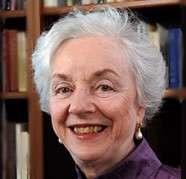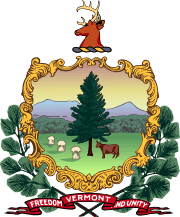Madeleine Kunin
| Madeleine Kunin | |
|---|---|
 | |
| United States Ambassador to Liechtenstein | |
|
In office March 14, 1997 – August 16, 1999 | |
| President | Bill Clinton |
| Preceded by | Larry Lawrence |
| Succeeded by | Richard Fredericks |
| United States Ambassador to Switzerland | |
|
In office August 19, 1996 – August 16, 1999 | |
| President | Bill Clinton |
| Preceded by | Larry Lawrence |
| Succeeded by | Richard Fredericks |
| United States Deputy Secretary of Education | |
|
In office 1993–1996 | |
| President | Bill Clinton |
| Preceded by | David T. Kearns |
| Succeeded by | Marshall Smith |
| 77th Governor of Vermont | |
|
In office January 10, 1985 – January 10, 1991 | |
| Lieutenant |
Peter Smith Howard Dean |
| Preceded by | Richard Snelling |
| Succeeded by | Richard Snelling |
| 74th Lieutenant Governor of Vermont | |
|
In office January 10, 1979 – January 10, 1983 | |
| Governor | Richard Snelling |
| Preceded by | Garry Buckley |
| Succeeded by | Peter Smith |
| Personal details | |
| Born |
Madeleine May September 28, 1933 Zürich, Switzerland |
| Political party | Democratic |
| Spouse(s) |
Arthur Kunin (1959–1995) John Hennessey (2006–present) |
| Alma mater |
University of Massachusetts, Amherst Columbia University University of Vermont |
| Religion | Judaism |
Madeleine May Kunin (born September 28, 1933) is an American diplomat and politician. She was the 77th Governor of Vermont from 1985 until 1991, as a member of the Democratic Party. She also served as United States Ambassador to Switzerland from 1996 to 1999. She was Vermont's first and, to date, only female governor as well as the first Jewish governor of Vermont. She was also the first Jewish woman to be elected governor of a U.S. state. Kunin is currently a James Marsh Professor-at-Large at the University of Vermont.[1]
Life and career
Kunin was born in Zürich, the daughter of Renee (Bloch) and Ferdinand May. Her family was Jewish. She moved to the United States as a child.[2] She received her bachelor's degree in history from the University of Massachusetts Amherst (1956), a master's degree from the Columbia University Graduate School of Journalism, and a master's degree in English from the University of Vermont. Prior to seeking elective office, she worked as a journalist for The Burlington Free Press, as a tour guide at the World's Fair, and as a part-time college professor. She was also involved in community activities, particularly in the area of women's rights, children, and literature. In 2012 her book, The New Feminist Agenda: Defining the Next Revolution for Women, Work, and Family, was published by Chelsea Green Publishing.[3]
Political career
In 1972, Kunin was defeated in her bid to join the Burlington Board of Aldermen. Later that year she was elected a Vermont State Representative, where in her first term she served as a member of the Government Operations Committee. Following her reelection in 1974, she was elected Minority Whip of the State House and appointed to the Appropriations Committee. After being elected to a third term in 1976, she was appointed Chairwoman of the Appropriations Committee, the first woman to assume this position. Kunin has written that when she served on the Appropriations Committee during his chairmanship, Emory A. Hebard, a conservative Republican who later served as Vermont State Treasurer, was a mentor, and gave her significant responsibilities despite her status as a member of the minority Democrats. When Hebard left the House, he successfully lobbied his former colleagues to name Kunin as chairwoman of the committee.[4]
In 1978 she was elected to the first of two terms as the 74th Lieutenant Governor of Vermont. Serving with Republican Richard Snelling, Kunin primarily served as President of the State Senate and worked with citizens around the state. She produced various studies in areas such as energy and day care and made policy recommendations to the Governor and Legislature. Kunin was a frequent speaker statewide during her time as lieutenant governor.
Kunin did not run for reelection as lieutenant governor in 1982, instead challenging Snelling for the governorship. She was unsuccessful, but in 1984 Snelling did not run for reelection, and Kunin was the successful Democratic nominee, defeating Republican John J. Easton, Jr. to win the first of her three terms as governor.
In 1986 Kunin ran for her second term as governor. Her opponents were Republican Peter Plympton Smith and independent Bernie Sanders. Smith received 38 percent of the vote, Sanders 14 percent, and Kunin won with 47 percent of the vote.[5]
She is the first woman in U.S. history to be elected governor three times. As governor she focused on the environment, education, and children's issues. She appointed the first woman to the State Supreme Court and created the family court system. She declined to seek reelection in 1990.
She was a member of the administration of President Bill Clinton, serving as deputy secretary of education of the United States from 1993 until 1997, when she became the ambassador to her native Switzerland, as well as to Liechtenstein. Prior to joining the Clinton Administration she worked in Clinton's campaign as a member of the search committee for the Vice Presidential nominee and on the transition team.
Personal life
Kunin is the author of the books The New Feminist Agenda: Defining the Next Revolution for Women, Work, and Family (2012), Pearls, Politics, and Power: How Women Can Win and Lead (2008) and Living a Political Life (1995) which chronicles her career prior to joining the U.S. Department of Education. She is a resident of Burlington, Vermont.[6]
Kunin is the mother of four children: Julia, Peter, Adam, and Daniel. She divorced her first husband, professor and former First Gentleman of Vermont Arthur Kunin, in 1995. She married John W. Hennessey Jr, a professor at Dartmouth College, in 2006.[7]
Governor Kunin was the sister of the late Edgar May, who was a Pulitzer Prize–winning journalist and a member of both the Vermont House of Representatives and Vermont State Senate.
Awards and honors
Governor Kunin has received more than twenty honorary degrees.
Kunin is a recipient of the International Center in New York's Award of Excellence.
In 1995, Kunin received the Foreign Language Advocacy Award from the Northeast Conference on the Teaching of Foreign Languages in recognition of her support for education, equal access for all children and equitable salaries for teachers.[8]
See also
References
- ↑ Vermont, University of. "James Marsh Professors-at-Large Program : University of Vermont". Retrieved September 24, 2016.
- ↑ "Madeleine May Kunin Facts". Retrieved September 24, 2016.
- ↑ "a book review by Elayne Clift: The New Feminist Agenda: Defining the Next Revolution for Women, Work, and Family". Retrieved September 24, 2016.
- ↑ Kunin, Madeleine (2012). The New Feminist Agenda. White River Junction, VT: Chelsea Green Publishing. pp. 176–177. ISBN 978-1-60358-425-8.
- ↑ Kunin, Madeleine May (5 February 2016). "When Bernie Sanders ran against me in Vermont". The Boston Globe. Retrieved 3 April 2016.
- ↑ "Pearls, Politics, and Power - How Women Can Win and Lead - Introduction - by Madeleine M. Kunin". Retrieved September 24, 2016.
- ↑ "Madeleine Kunin and John Hennessey". The New York Times. February 26, 2006. Retrieved September 24, 2016.
- ↑ "The James W. Dodge Foreign Language Advocate Award". Northeast Conference on the Teaching of Foreign Languages. Retrieved August 28, 2014.
External links
- Appearances on C-SPAN
- Video clip of Kunin documentary
- Jewish Women and the Feminist Revolution from the Jewish Women's Archive
- New York Times "Vows" article about Kunin's marriage (2006)
- Inventory of the Madeleine May Kunin Collection, Special Collections, University of Vermont Library
- Further Biographical Information
- Brief Profile of Governor Madeleine May Kunin
| Political offices | ||
|---|---|---|
| Preceded by Garry Buckley |
Lieutenant Governor of Vermont 1979–1983 |
Succeeded by Peter Smith |
| Preceded by Richard Snelling |
Governor of Vermont 1985–1991 |
Succeeded by Richard Snelling |
| Party political offices | ||
| Preceded by Jerome Diamond |
Democratic nominee for Governor of Vermont 1982, 1984, 1986, 1988 |
Succeeded by Peter Welch |
| Diplomatic posts | ||
| Preceded by Larry Lawrence |
United States Ambassador to Switzerland 1996–1999 |
Succeeded by Richard Fredericks |
| United States Ambassador to Liechtenstein 1997–1999 | ||
